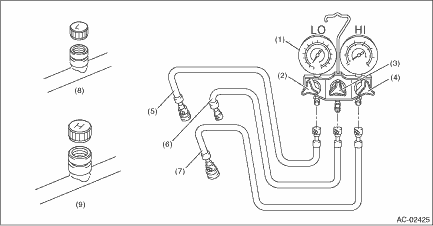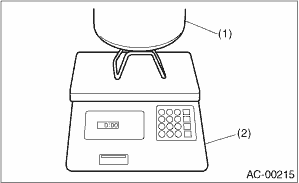Subaru Crosstrek Service Manual: Refrigerant charging procedure Procedure
HVAC SYSTEM (HEATER, VENTILATOR AND A/C) > Refrigerant Charging Procedure
PROCEDURE
CAUTION:
• While working, be sure to wear protective goggles and protective gloves.
• Air in the cycle can cause insufficient air conditioning, and water in the cycle can cause clogging in the cycle (icing) and rust. To remove this air and water content, use a vacuum pump to perform evacuation before filling with refrigerant. By making the inside of the cycle a vacuum, the water content will evaporate even at normal temperatures, and can be removed.

(1) | Manifold gauge | (4) | High pressure valve | (7) | High-pressure hose |
(2) | Low pressure valve | (5) | Low-pressure hose | (8) | Low-pressure side service port |
(3) | Center valve | (6) | Center manifold hose (vacuum pump and charge) | (9) | High-pressure side service port |
1. Attach the manifold gauge set.
Preparation tool:
Manifold gauge set
(1) Check that all valves are fully closed.
(2) Install the low/high pressure hoses to the service ports on the low/high pressure sides of the vehicle respectively.
CAUTION:
Confirm that the connections are secure.
(3) Connect the center manifold hose of the manifold gauge to the vacuum pump.
Preparation tool:
Vacuum pump
2. Perform evacuation.
CAUTION:
Make sure to perform evacuation using a vacuum pump.
(1) Open the low-pressure valve, high-pressure valve and center valve.
(2) Operate the vacuum pump.
(3) Perform evacuation for 5 minutes or more, and when the low pressure gauge needle reaches −0.1 MPa (−1.0 kgf/cm2, −14 psi), close the center manifold hose valve, and stop the vacuum pump.
(4) Leave alone for 5 to 10 minutes after closing the low pressure side and high pressure side valves, and check whether there is any change in the low pressure gauge needle indication.
If the needle position changes, this indicates a leak. Check the pipe and hose connections, and repair the location with the problem.
After repair, retry charging the refrigerant from the step 1).
(5) If there is no leakage, continue evacuation for additional 20 — 30 minutes, close all valves and then stop the vacuum pump.
3. Charge refrigerant.
(1) Follow the can tap operation manual to attach it to the refrigerant can.
Preparation tool:
Can tap
(2) Disconnect the center manifold hose from the vacuum pump, and connect the hose to the tap valve.
Preparation tool:
Weight scale
NOTE:
When 13.6 kg (30 lb) refrigerant container (1) is used, measure the amount of refrigerant with a refrigerant charging scale (2), and connect with the center manifold hose.

(3) Open the tap valve of HFC-134a supply container (refrigerant can or refrigerant container).
(4) Loosen the center manifold hose connection on the manifold gauge for a few seconds (if there is a purge valve on the manifold gauge, push this instead) to allow the air in the center manifold hose to be bled by the refrigerant pressure.
(5) Open the low-pressure side and high-pressure side valves of the manifold gauge to fill with refrigerant.
NOTE:
If the HFC-134a supply container is empty, close all manifold gauge valves and the tap valve of HFC-134a supply container, and replace the empty supply container with a new one. After replacing with a new HFC-134a supply container, perform air purge, and resume the filling operation.
(6) If the low pressure gauge indicates approximately 0.2 MPa (2.0 kgf/cm2, 29 psi) or refrigerant filling efficiency drops, close the low-pressure side valve and high-pressure side valve.
(7) Check that the low-pressure side valve and high-pressure side valve are closed, turn off the A/C switch and start the engine.
CAUTION:
When filling with the engine running, do not open the high pressure side valve. Always fill from the low pressure side.
(8) To prevent damage to the compressor, push the A/C switch ON-OFF quickly a few times.
(9) Set the vehicle to the following conditions.
Item | Condition |
Engine speed | 1,500 r/min |
A/C switch | ON |
Temperature adjustment dial | LO (MAX COOL) |
Fan dial | HI (MAX) |
FRESH/RECIRC switch | RECIRC |
Air flow control dial or switch | VENT |
Window | OPEN |
(10) Open the low-pressure side valve, check the refrigerant pressure with a manifold gauge and fill with refrigerant up to the specified amount. Refrigerant Pressure with Manifold Gauge Set > INSPECTION">
4. Using an electronic leak detector (leak tester), check for refrigerant leaks in the system. Refrigerant Leak Check > INSPECTION">
5. After filling with refrigerant, close all valves and remove the manifold gauge set.
6. Attach cap to the service port of the low-pressure side and high-pressure side.
 Pressure switch (triple pressure switch) Inspection
Pressure switch (triple pressure switch) Inspection
HVAC SYSTEM (HEATER, VENTILATOR AND A/C) > Pressure Switch (Triple Pressure Switch)INSPECTION1. Connect the manifold gauge to the service valve on the high-pressure side.2. Disconnect the connector ...
 Refrigerant leak check Inspection
Refrigerant leak check Inspection
HVAC SYSTEM (HEATER, VENTILATOR AND A/C) > Refrigerant Leak CheckINSPECTION1. Attach the manifold gauge set.Preparation tool:Manifold gauge set(1) Check that all valves are fully closed.(2) Install ...
Other materials:
List of diagnostic trouble code (dtc) List
AIRBAG SYSTEM (DIAGNOSTICS) > List of Diagnostic Trouble Code (DTC)LISTDTCItemContent of diagnosisReferenceU0073CONTROL MODULE COMMUNICATION BUS OFFCAN communication error occurred. Diagnostic Chart with Trouble Code > DTC U0073 CONTROL MODULE COMMUNICATION BUS OFF">B1000AIRBAG ECU MAL ...
Unlocking
Perform steps 1 to 5 described in "Registration".
NOTE
You cannot unlock by PIN Code
Access in the following cases.
when the access key is within the
operating ranges
when the ignition switch is in the
"ACC" or "ON" position
If you make an operation error
during the unlocking proced ...
Except U.S.-spec. models (type B)
The illustration above is a typical example. For some models, the combination
meter
may be slightly different than that shown in the illustration.
Tachometer
Multi information display
Fuel gauge
Select lever/gear position indicator
Speedometer
Trip meter A/B selection and trip m ...
